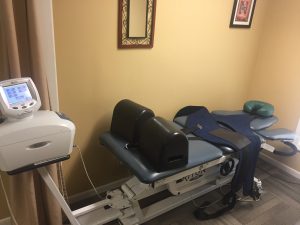 If you’re looking for a tool to help improve patient comfort for spinal therapy procedures, then the Triton DTS TRT Spine Therapy Table is for you. This useful and functional table is used for both traction and spinal decompression therapy. Spinal decompression therapy or traction is a procedure that stretches a patient’s spine with the help of a traction table. During the process, any pressure is lifted from the spinal discs, allowing herniated or bulging discs to retract, alleviating pressure from nerves and other parts of the spine that may be causing pain. The end goal of the procedure is to alleviate leg or back pain. This can also be used for various other conditions such as joint issues, spondylosis, spondylithesis, sciatica, and other spine complaints.
If you’re looking for a tool to help improve patient comfort for spinal therapy procedures, then the Triton DTS TRT Spine Therapy Table is for you. This useful and functional table is used for both traction and spinal decompression therapy. Spinal decompression therapy or traction is a procedure that stretches a patient’s spine with the help of a traction table. During the process, any pressure is lifted from the spinal discs, allowing herniated or bulging discs to retract, alleviating pressure from nerves and other parts of the spine that may be causing pain. The end goal of the procedure is to alleviate leg or back pain. This can also be used for various other conditions such as joint issues, spondylosis, spondylithesis, sciatica, and other spine complaints.
Anyone who has experienced reoccurring back pain knows how much it can disrupt day-to-day activities. They usually feel “compressed” in a way. More chiropractors and other healthcare professionals are beginning to explore therapies like spinal decompression therapy or traction as an effective therapy. The Triton DTS TRT Spine Therapy Table could help more patients live pain-free lives. So what makes this table so popular compared to other spinal therapy tables?
Triton DTS TRT Spine Therapy Table Features
The Triton DTS TRT Spine Therapy Table boasts a variety of features that help it stand apart from the rest. For starters, the table has a newly designed pelvic tilt area that is capable of inclining a patient’s pelvis from zero degrees to 20 degrees. Not only does this improve a patient’s comfort, but the table also alleviates lower back pain by addressing pelvic asymmetry. It also improves the function of a patient’s lumbar spine, alleviating pain and discomfort even more.
Another great feature of this table is that it offers better access to the thoracic and cervical spine. The arm and chest sections can be adjusted and the head section can tilt 35 degrees. The grab bars, which can be adjusted or tucked away, allow for hanging traction without the need for thoracic restraints. In addition, the table allows for improved patient stability thanks to its axilla posts, which are also removable and are designed to prevent a patient from slipping during therapy. Other features include:
Lockable casters
Easy access controls when positioning a patient
Wide cushions for added patient comfort
Adjustable height controls
Safety switch to stop machine by patient
Computer that controls the traction using different protocols
